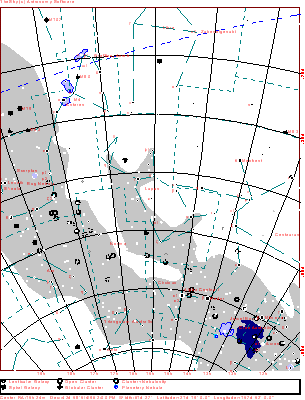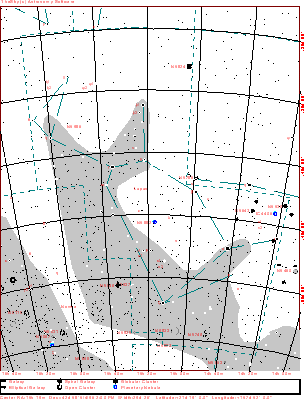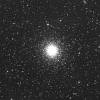
| Home | Deepsky Atlas | TheAstronews | Links | Solar System | ||||||

Hawaiian Astronomical SocietyConstellations: Lupus -- Centaur's Wineskin, Wolf, Panther, Baby killing King |
||||||||||
Traditionally this part of the sky has received many appellations. Chiron's wineskin, a panther, a generalized, fierce beast, and a wolf. The wolf title stuck with the translation of Ptolemy's Almagest into Latin.
The story of the wolf is not for those weak of stomach or faint of heart. Lycaon was a legendary king of Arcadia, a remote land in the central Peloponnesus. He had fifty sons, and together they grew famous for their impiety and cruelty. He also had a daughter named Callisto.
Lycaon and his sons sacrificed a child to Zeus' altar, and fed the child's bowels to Zeus, who was disguised as a laborer. There are two versions of what happened next. First, Zeus blasted him and all but one of Lycaon's sons (Nyctimus). The resulting storm developed into Deucalion's flood.
Another version has Lycaon transformed into a wolf for sacrificing a child on the altar of Zeus. The story perhaps explains a bizarre ceremony held in honor of Zeus at Mt. Lycaeus. In this ceremony a man was sacrificed and eaten. Any person who tastes the entrails is immediately transformed into a wolf, and remains that way for nine years, after which he might become a man again, if he has not tasted human flesh while a wolf. So goes the story of Lupus the wolf.
Who said mythology was pretty?

Click the map for a 916x1200 version of the above. Click here for a map better suited for use in the field.

This is a more detailed map of the constellation. It displays stars to magnitude 10, and deepsky objects to magnitude 12. Click here for a map better suited for use in the field.
 27k JPEG NGC5986 (Bennett 70) is a globular cluster located 4° NW of Gamma Lupi. One of Dreyer's remarkable objects, he describes this globular as very bright (mag7.1), large (9.8'), round, and very gradually brightening toward the middle. Image from the Digital Sky Survey covers 15'. 27k JPEG NGC5986 (Bennett 70) is a globular cluster located 4° NW of Gamma Lupi. One of Dreyer's remarkable objects, he describes this globular as very bright (mag7.1), large (9.8'), round, and very gradually brightening toward the middle. Image from the Digital Sky Survey covers 15'.
|
NGC5946 sits just across the border in Norma, 1.2° to the east. Another globular cluster, it is quite bright (mag. 9.6), fairly large (7.1'), round, with little brightening toward the middle. Image is a mosaic of two downloads from the Digital Sky Survey.
|
 48k JPEG NGC5824 (Bennett 67) is a globular cluster located near the Centaurus border, 7.8° south of Sigma Librae, 4.8° north-west of Phi-1 Lupi. The description reads: Fairly bright (mag.9), small (6.2'), with a stellar nucleus. Individual stars are mag. 15.5 and fainter, a challenge for a 12" under good conditions. From the Digital Sky Survey. 48k JPEG NGC5824 (Bennett 67) is a globular cluster located near the Centaurus border, 7.8° south of Sigma Librae, 4.8° north-west of Phi-1 Lupi. The description reads: Fairly bright (mag.9), small (6.2'), with a stellar nucleus. Individual stars are mag. 15.5 and fainter, a challenge for a 12" under good conditions. From the Digital Sky Survey.
|
 82k JPEG NGC5822 is a open cluster located 2.5° SSW of Zeta Lupi. Dreyer describes this mag. 6.5 cluster as very large (40'), rich (150 stars), little condensed, with stars ranging from mags. 9-12. From the Digital Sky Survey. 82k JPEG NGC5822 is a open cluster located 2.5° SSW of Zeta Lupi. Dreyer describes this mag. 6.5 cluster as very large (40'), rich (150 stars), little condensed, with stars ranging from mags. 9-12. From the Digital Sky Survey.
|
If you have any questions about the Hawaiian Astronomical Society
please
(link requires javascript).